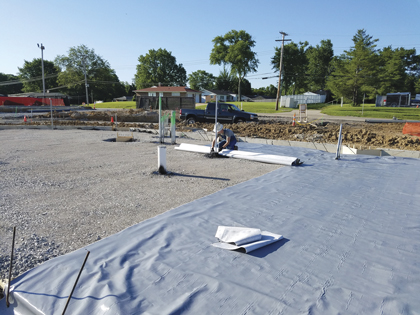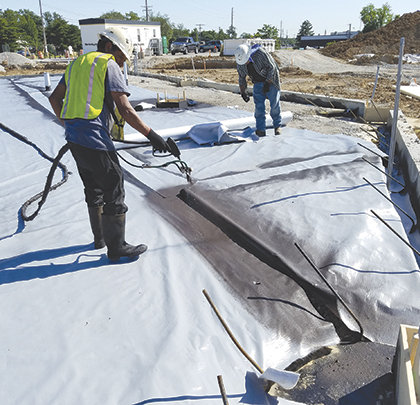Before selecting a contractor and breaking ground for a new structure, it is important for an environmental professional to conduct a Phase I Environmental Site Assessment and, if warranted, a Phase II investigation, which may include testing for the potential of vapor intrusion.
DEALING WITH VAPOR INTRUSION
Vapor intrusion is the hazardous migration of chemical vapors into a building from contaminated soil, groundwater, and/or soil vapor. This contamination comes in the form of petroleum products or volatile chemicals including volatile or semi-volatile organic compounds, in addition to some inorganic analytes. Chemical vapor migration cannot be observed by sight or by smell, and the risks associated with unmitigated vapor intrusion do not always manifest themselves immediately and include both the health of the building’s occupants and surrounding sites. When vapor intrusion occurs, the habitable zone’s air quality suffers. Certain sites are of higher risk than others due to their proximity to establishments (past or present) whose operations potentially contributed to the contaminated soil.
REAL-WORLD EXAMPLE
Vapor Mitigation Strategies, a Wellington Environmental company and installer of vapor intrusion barrier solutions, recently completed a single-day install of a 4,600-square-foot chemical vapor barrier system in St. Louis to reduce the risk of chemical vapor exposure.
Vapor mitigation systems are being recommended and installed at the lowest level of new structures when they are determined to be in a high-risk area and/or when contamination is confirmed by testing.
“The previous building was a car service center and when the property was purchased by a bank, the bank decided to tear down and build a new structure on the existing lot,” says Wes Robb, director of technical strategies and applications at Vapor Mitigation Strategies.
“Before completing construction of the new facility, a chemical vapor barrier was installed because many former car service centers used vehicle fluids and cleaning solvents that may have emitted toxic gasses into the subsurface soil vapor over many years.”
Improper handling, previously unregulated disposal or accidental spills and leaks of these car service chemicals may have introduced themselves into the subsurface where they emit toxic gasses into the soil vapor. These chemical vapors can cause air quality and health concerns for occupants of buildings directly over and adjacent to the source contamination.
“To reduce the risk of exposure to vapor emanating from subsurface contamination through the concrete floor and utilities openings of the building (known as vapor intrusion), we installed a chemical vapor barrier system,” Robb adds.
OPTIONS AND INSTALL
There are a couple of different mitigation options available. One of the most common options comes in the form of a composite membrane system.
Vapor Mitigation Strategies installed a Geo-Seal® Spray-on Membrane Gas Vapor Barrier, which included three layers: 5 mil Geo-Seal FILM 5 (high-density polyethylene layer), 30 mil Geo-Seal CORE (spray-applied copolymer modified asphaltic membrane), and an 18 mil Geo-Seal BASE (high-density polyethylene layer).

Above: Crew rolls out lowest layer of tarp and makes cut-ins around the uprights.
Featured Image: Spraying the first layer of closure to all seams of the tarp.
To install this system, Vapor Mitigation Strategies’ crew prepared the surface by removing potential penetrating materials. Next, they rolled out the lowest layer of tarp, the 18 mil Geo-Seal BASE (high-density polyethylene layer), and made cut-ins around the uprights.
This step was followed by the application of the 30 mil Geo-Seal CORE (spray- applied copolymer modified asphaltic membrane) on the first layer of closure to all seams and uprights of the tarp. Next, they rolled out the final tarp, the 5 mil Geo-Seal FILM 5 (high-density polyethylene layer) and applied a second seal to all the seams and uprights. The thickness measurements and smoke tests of the first two layers are conducted prior to the addition of the final layer to ensure the chemical vapor barrier system was installed properly.
This solution, which has been accepted by state environmental agencies, branches of the military, and environmental consulting firms around the world, takes the advantages of chemically resistant, high-density polyethylene and combines it with the benefits of spray-applied membranes.
“Vapor Mitigation Strategies did an excellent job of coordinating their work with our general contractor,” says Kevin Lasater, owner’s representative and president of Doubletree Construction Consulting, LLC, who has been in the construction industry for 40 years.
“They installed the chemical vapor barrier on-schedule and within budget, and the new property owner was very pleased with their competitive price and quality of their work.”
With this new chemical vapor barrier system in place, the bank mitigated any potential vapor intrusion issue and reduced the risk to human health.
UNDERSTANDING THE REQUIREMENTS
It is important for construction contractors to understand what is required when they receive the specifications for a chemical vapor mitigation system. Contractors sometimes mistake the chemical vapor barrier for a simple moisture barrier. If this occurs, the vapor intrusion problem will not be properly mitigated, leading to possible future litigation. For the installation, contractors should hire a qualified subcontractor who offers both an installation warranty and a third-party certified inspector. Additionally, the material for the chemical vapor mitigation system should be accompanied by a manufacturer warranty.
It is most efficient to design a vapor mitigation system during construction of a new building. There are, however, options to retrofit a building when vapor intrusion is subsequently discovered. For the retrofit process, a specially engineered sealant product is applied to the basement floor and walls of the existing structure to repel the transmission of potentially harmful sub-slab vapor. This approach has proved to be an effective solution. ■
For More Information:
Vapor Mitigation Strategies, a St. Louis-based Wellington Environmental Company, offers vapor intrusion barrier solutions to both new building projects and existing structures. Vapor Mitigation Strategies brings years of knowledge and experience to any job where vapor intrusion is a risk and a vapor intrusion barrier is required. The composite technology the company installs provides multiple layers of protection. For more, visit www.vapormitigationstrategies.com.
_________________________________________________________________________
Modern Contractor Solutions, October 2017
Did you enjoy this article?
Subscribe to the FREE Digital Edition of Modern Contractor Solutions magazine.



